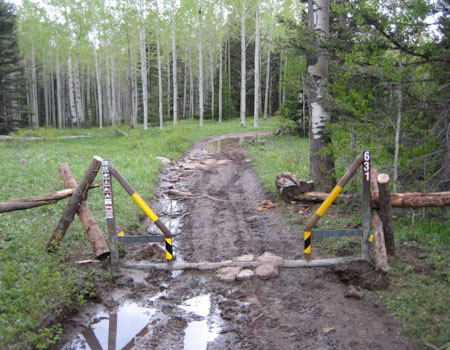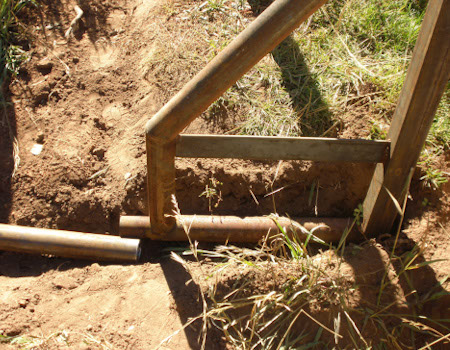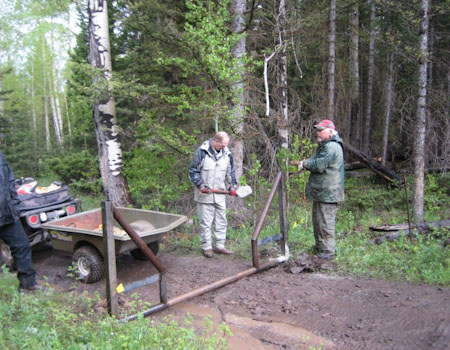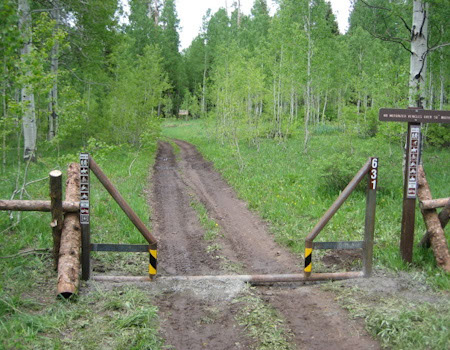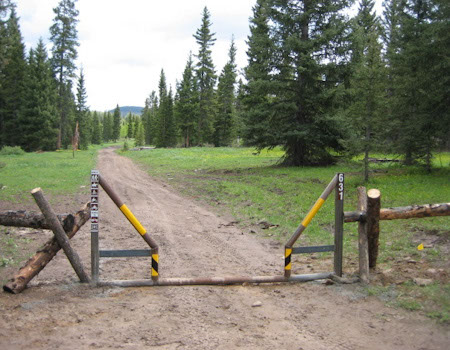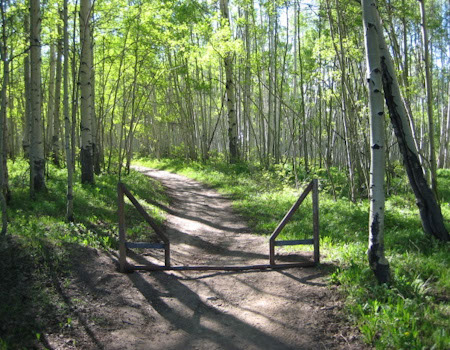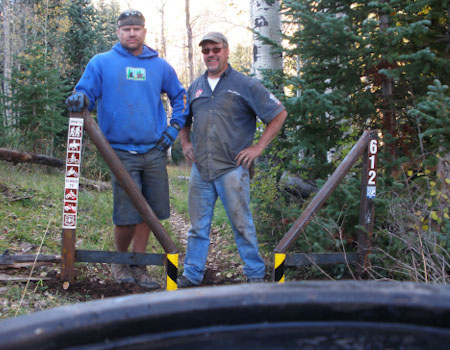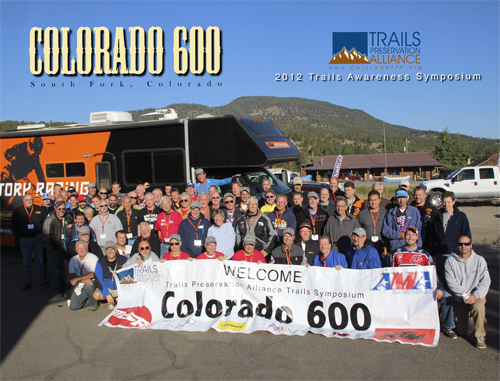Senator Michael Bennet
Att: John Whitney
835 East 2nd Avenue, Suite 206
Durango, Colorado 81301
RE: Hermosa Watershed Proposal
Dear Mr. Whitney;
I wanted to follow up with you regarding our chain of emails on this proposal, your willingness to discuss this proposal is appreciated. We are submitting these comments to clarify some of the discussion points in the emails and phone call. Given the brief nature of these discussions, it is possible that some of our concerns may not have been clearly outlined. The Organizations believe that a review of the meeting minutes and various proposal maps will significantly aid in clarification of our concerns.
COHVCO is a grassroots advocacy organization of approximately 2,500 members seeking to represent, assist, educate, and empower all OHV recreationists in the protection and promotion of off-highway motorized recreation throughout Colorado. COHVCO is an environmental organization that advocates and promotes the responsible use and conservation of our public lands and natural resources to preserve their aesthetic and recreational qualities for future generations.
CSA was founded in 1970 to unite winter motorized recreationists across the state to enjoy their passion. CSA currently has 2,500 members. CSA has also become the voice of organized snowmobiling seeking to advance, promote and preserve the sport of snowmobiling through work with Federal and state land management agencies and local, state and federal legislators telling the truth about our sport.
TPA is a 100 percent volunteer organization whose intention is to be a viable partner, working with the United States Forest Service (USFS) and the Bureau of Land Management (BLM) to preserve the sport of trail riding. The TPA acts as an advocate of the sport and takes the necessary action to insure that the USFS and BLM allocate to trail riding a fair and equitable percentage of access to public lands.
Our Organizations major concern is the final position of the Workgroup must be accurately and clearly reflected in the Legislation to avoid the need for future planning efforts in the area shortly after the Legislation is passed and/or confusion in the interpretation of the Legislation. The Organizations have participated in several other planning groups for specific areas in the state and clarity of the final proposal is an area where improvement can be made. Often minimal clarity issues in the Legislation are compounded by the fact that members of the work group often move on with their lives making them hard to locate or otherwise unavailable to clarify what was the true intent or issue to be addressed with specific provisions of the legislation. This lack of clarity can result in ongoing opposition to motorized access in areas specifically addressed by the Workgroup, despite the efforts to avoid this type of conflict. Avoiding this type of conflict will improve public support for the process and support for the final work product.
1. Lessons learned from previous Workgroup/Legislation projects.
The Organizations believe a brief summary of our experiences with two prior workgroups will clarify the basis for our concerns regarding the Proposal and related processes. Senator Udall’s James Peak Wilderness Bill was the result of a multi-year working group process that brought together a wide range of users of the area, including the COHVCO and the Rollins Pass Association. As we discussed briefly, clarity of the final Legislation was an issue with the James Peak Wilderness expansion and an issue where the Rollins Pass Association still vigorously asserts the Legislation did not accurately reflect what their understanding of the proposal was. The Rollins Pass Association believed a tunnel in the proposal area was supposed to be rehabilitated and reopened with the assistance of the Forest Service. While the legislation was passed in 2002, the tunnel remains closed to this day as the Forest Service interpretation of the Legislation was significantly different than that of the Rollins Pass Association. Obviously this type of an on-going conflict is something we would like to avoid in the Hermosa area.
The James Peak Legislation does provide good guidance for development of accurate and complete special management area boundaries. The James Peak Legislation boundaries accurately reflected the planning area and allowed recent attempts to again expand designated Wilderness in the planning area to be recognized as areas that had been found unsuitable for Wilderness designation by the Workgroup. This clarity of designation and intent was critical in avoiding the high degree of frustration for those that had participated in development of the Workgroup recommendation. The desire of these participants was to develop a final plan for the James Peak/Rollins Pass area for the foreseeable future. Those that opposed the final boundaries in the Workgroup proposal hoped to reopen discussions regarding Wilderness in the areas previously identified as unsuitable for Wilderness by the Workgroup consensus, which clearly would have violated the clear intent of the Workgroup. The Organizations believe the Legislation must provide sufficient clarity to limit possible impacts from subsequent proposals/planning by those that were not satisfied with the Workgroup consensus.
A brief explanation of the experiences from the second Workgroup project will further clarify the basis for our concerns regarding subsequent planning activities required under the proposed Legislation. CSA was deeply involved in a Workgroup planning effort for a heavily used multiple use winter area in the Snowy Range area of the Medicine Bow/Routt National Forest. The Workgroup efforts spanned almost two years and concluded areas south of the major roadway accessing this multiple use area would be designated non-motorized and the area north of the roadway would remain open to motorized. The Workgroup found that parking areas would be developed for both areas to address significant safety issues with parking in the area.
All parties to this Workgroup agreed that changes needed to implement the consensus position would be not opposed in subsequent planning by the parties participating in the Workgroup. The restrictions to motorized access south of the roadway were rapidly implemented and non-motorized parking was rapidly addressed without opposition from the motorized community. Unfortunately, the planning process for implementation of the Workgroup changes benefitting motorized access has been vigorously opposed by those opposed to any motorized access. This vocal opposition has stalled the planned changes despite the consensus that was reached which found the motorized changes were acceptable to all in the Workgroup. This continued opposition has fostered a significant amount of frustration for those that participated in the Workgroup and significant expense for motorized users and the Forest Service, which the consensus position was intended to avoid. The conclusions reached by the Workgroup addressing parking for motorized users remains incomplete despite almost 10 years passing since the closures south of the roadway. The Organizations would like to avoid developing another situation similar to this and while the Workgroup conclusions cannot include a penalty provision for subsequent violation, the Legislative language can be drawn as tightly as possible to avoid any ambiguity and to directly rebut any issues later raised against the Workgroup recommendation.
As more completely addressed in the subsequent portions of these comments, the Organizations have specific concerns about boundaries of the SMA impacts on winter usage and the level of protection of identified motorized routes in subsequent planning addressing summer usage. Our Organizations believe with resolution of these issues this proposal would strike a reasonable balance of uses in this particular area and would not be opposed by our Organizations.
2. Winter usage concerns/southwestern boundary of SMA.
The Organizations believe the southwestern boundary of the SMA must be adjusted to reflect the larger boundary of the Recommended Wilderness under the San Juan Forest Plan that was the starting point for the discussions in the Workgroup. The current boundary of the SMA does not include the area in the southwest portion of the Recommended Wilderness area in the San Juan plan that was determined to be unsuitable for Wilderness designation by the Workgroup. Drawing the southwestern boundary of the SMA to include this area within the SMA is a significant issue for winter users, as the area is heavily used for winter motorized recreation and has been the basis of an on-going discussion regarding management for a long time.
Per the September 2008 meeting minutes of the Workgroup, the starting point for discussions of the SMA boundary was the recommended Wilderness area boundary currently provided for in the San Juan Forest Plan. These meeting minutes specifically identify that numerous other groups voiced serious concerns about the Wilderness area boundary under the Forest Plan. These concerns center around the southwestern boundary of the recommended Wilderness under the Forest Plan. The meeting minutes specifically summarize these concerns as follows:
“• Wilderness designation: The SJPLC’s draft plan revision proposes wilderness designation for much of the Hermosa Area on the west side. A working group formed by the Wilderness Society and the San Juan Citizens Alliance and supported by Trails 2000, a trails advocacy group, has been meeting for several months to figure out how to work with the management plan as proposed. The effort was prompted by conflicts between the proposed wilderness designation and current trail use, particularly by mountain-bikers. The current wilderness proposal includes a 4.5-mile section of the Colorado Trail that’s used by mountain-bikers as a key north-south connector.
This environmental working group has suggested different boundaries for the proposed Wilderness Area. The group also recommends that the remainder of the Hermosa Area be protected by some special designation that would be less stringent than wilderness. They are calling this the Hermosa Watershed Protection Area. It would be bounded by the Hermosa headwaters on the north, Bear Creek on the west, Highway 550 on the east and Junction Creek on the south. It could be designated a National Recreation Area, National Scenic Area or National Conservation Area (NCA), a designation typically given to BLM lands. These protections are defined by the legislation that creates them; there is not a single over-riding act that spells out how such an area should be managed. Such designations often include the limiting of motorized use to certain routes, a mineral withdrawal, and a prohibition on timber-harvesting. The continuation of grazing is often allowed. Most grazing currently takes place on the east side of the Hermosa Area, so there could be language to allow stock ponds and range improvements.”1
CSA must note that areas to the west of the Colorado Trail currently relied on as the boundary of the SMA are heavily used for motorized winter recreation. These riding areas are accessed by portions of the Colorado Trail designated as snowmobile trail and by several routes that access this areas from the west. This usage, in conjunction with the noted mechanized summer travel weighed heavily against the suitability of the area for designation as Wilderness. The Organizations believe this usage must be protected with the SMA designations in order to avoid future discussions about the same area, such as those recently occurring in the area addressed by Senator Udall’s James Peak Wilderness legislation.
A review of the San Juan Resource Management Plan (“RMP”) finds that summer motorized and mechanized routes were addressed in the Recommended Wilderness proposal area, but the RMP does not address winter motorized usage of the area. Per the San Juan RMP, the Recommended
Wilderness boundary is as follows:
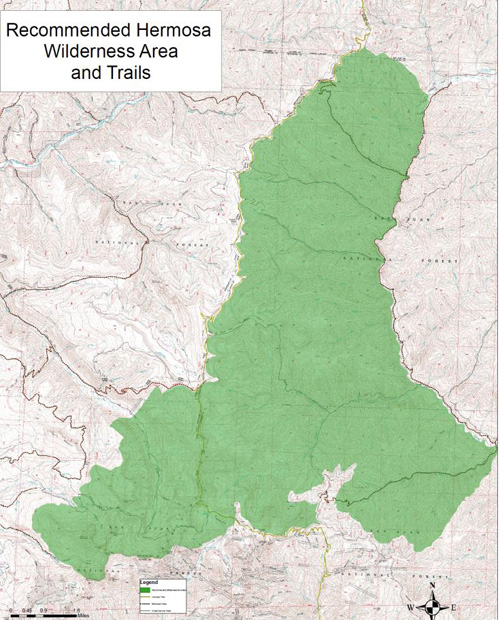 2
2
The San Juan Public RMP provides the following snowmobile suitability map, which accurately
reflects the winter motorized usage of this area. The RMP does not clarify why winter motorized usage, which has a long history in this area, was not addressed in the development of the Recommended Wilderness boundary. The RMP snowmobile boundaries are as follows:
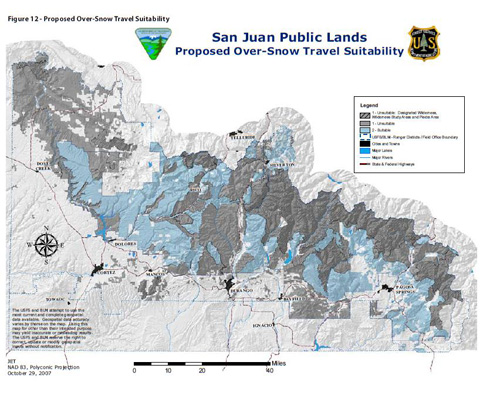 3
3
Forest Service mapping created in conjunction with the Workgroup proposal identify that almost all areas suitable for snowmobiling are outside the boundary of both the Wilderness area proposed in the Workgroup recommendation and the SMA boundary in this area.
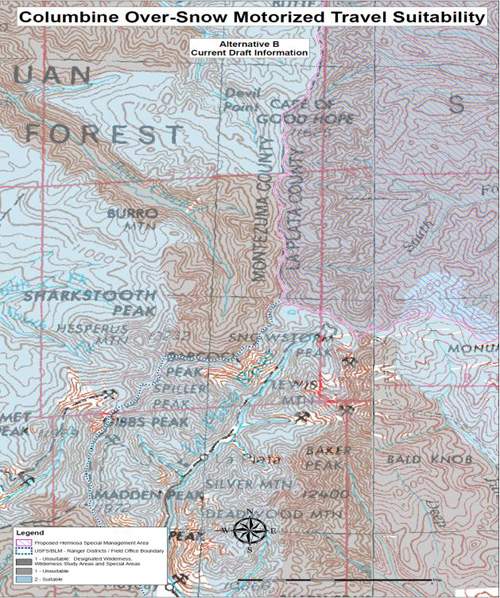 4
4
Current information regarding the usage of areas outside both the proposed Wilderness area and the SMA boundary proposed by the Workgroup reflect the high levels of winter motorized recreation in the area outside the SMA boundary. Trail maps from the San Juan Snowmobile Club map reflects the large number of designated but ungroomed motorized trails that provide access to the area from the south and west.
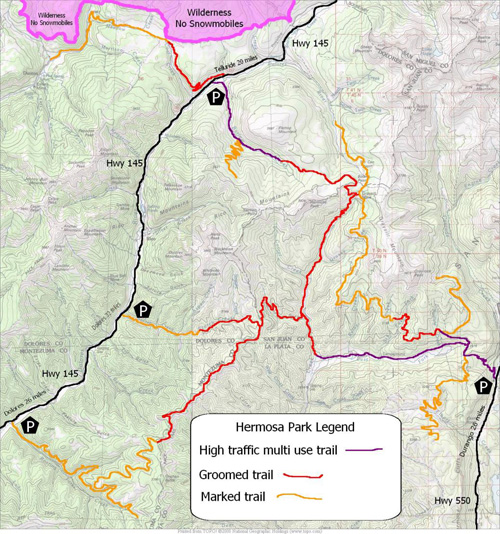 5
5
Workgroup proposes a southwestern boundary for the SMA as follows:
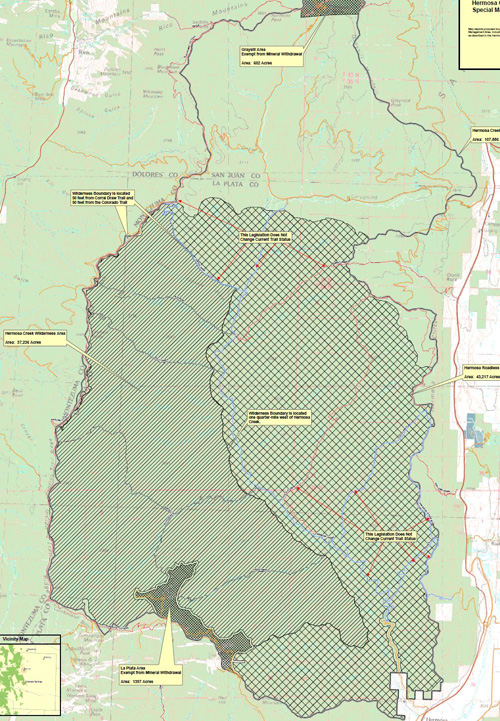 6
6
The Organizations truly appreciate that the southwestern Wilderness/SMA Boundary was drawn to avoid mechanized and motorized use in the area to the west of the Wilderness area. The Organizations are very concerned future proposals again asserting a need for Wilderness
designation of this area will be forthcoming after the Workgroup specifically concluded this area should not be Wilderness based on the levels of mechanized and winter motorized usage of the area.
The Organizations vigorously assert amending the southwestern boundary of the SMA to
designate the area of RMP Recommended Wilderness as inside the SMA and clearly allowing
the SMA level of uses must occur, as it clearly was the intent of the Workgroup to avoid
Wilderness designation in this area. The Organizations believe that any motorized or mechanized routes that are included in the expanded SMA boundary should be given similar levels of protection as found in other areas of the SMA. (Please note the map below is for discussion
purposes only.)
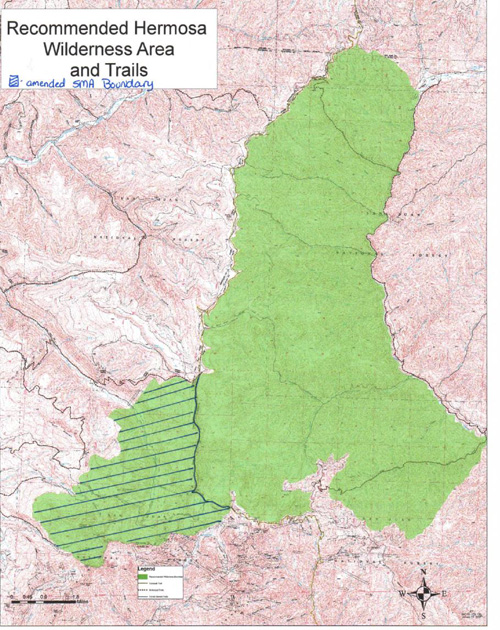
The Organizations believe this amended SMA boundary will sufficiently address the intent of the Workgroup regarding this area and avoid possible future frustrations regarding usage of this area. The Organizations notes that protection of existing recreational usage was a priority of the Workgroup and expanding the SMA boundary is clearly in furtherance of this goal and minimizes future proposals regarding usage of the area. The Organizations have to note that minimizing these types of conflicts was a major reason the Workgroup was convened.
3a. Protection of summer multiple use routes must be increased in the Legislation.
The Workgroup clearly and repeatedly identified protection of the existing multiple use designated trail system for future generations as a priority value in the Workgroup process.7 Our Organizations are vigorous supporters of the use of designated routes on all public lands and are vigorous supporters of this portion of the Proposal. Representative’s of the summer motorized community left the Workgroup process with the understanding that routes in the planning area had been permanently protected from closure under Federal law. A review of the Legislation reveals there is a significant gray area regarding actual treatment of the trails in subsequent planning for implementation of the Workgroup recommendation. The Organizations are aware that this gray area has resulted in a high level of frustration with those representatives as a result of this inconsistency.
As outlined previously in these comments, planning actions implementing Workgroup changes for motorized access in the planning area after approval of the final Legislation have often frustrated Workgroup recommendations. It has been our experience that those opposing motorized access continue with vigorous opposition in the planning process after final Legislation. Our Organizations would like to avoid the possibility of this type of ongoing conflict with the Hermosa proposal. Strengthening proposed legislative language regarding motorized routes would be a significant step towards mitigating these concerns. It has been our experience that documents regarding the Working Group are not easily located and participants move on, making legislative clarity a highly valuable tool in future planning. Public support will be key for on the ground implementation and allowing future working group proposals for public lands to be more warmly received and hopefully more effective. Legislative clarity is again a key component in developing and sustaining this public support.
3(b)(1). The proposed Bill title does not identify multiple usage.
Our Organizations believe the legislative language must be exceptionally clear regarding the treatment of motorized routes and the lack of conflict between the user groups regarding preservation of this trail network that the working group operated under. Our Organizations are concerned that the bill title is:
“To designate certain Federal land in the San Juan National Forest in the State of Colorado as wilderness, and for other purposes.” 8
Our Organizations believe the multiple uses of the area that are sought to be protected with the consensus position of the Working Group are not accurately summarized as a Wilderness designation. When the Workgroup process began, there was significant outreach clearly stating this Workgroup was part of various Wilderness initiatives and the work group was targeting protection of stream values in the area.9 We believe the bill title must be amended to accurately reflect the multiple uses of the SMA that is created, of which Wilderness is only a small portion. We believe this change will increase accuracy of the Legislation and avoid possible misinterpretation of the Workgroup efforts and the basic intent of the Workgroup. Clearly the open nature of the Workgroup environment aided in bringing user groups to the table.
3(b)(2) Motorized recreation is not specifically identified as an authorized activity in the SMA.
While the Workgroup report specifically outlines the desire to protect all trails in the planning area, this clarity is not reflected in the authorized uses of the SMA in the legislation. The authorized uses of the SMA only broadly include recreation. 10We do not believe this narrow definition accurately reflects the working groups broad intent to protect the motorized and mechanized access for a large portion of the SMA. The Organizations believe these uses must be specifically identified as a permitted use of the SMA in the legislation to avoid further future conflict regarding use of this area. This must be corrected and clarified.
3(b)(3) The existing trail network is created pursuant to forest planning regulations and would not be a usage by permit.
The lack of clarity in the proposed Legislation further carries into the broad management requirements for the SMA. Only motorized and mechanized activities that occur under permit are specifically identified and protected in the Legislation.11Our Organizations must note that the current trail network sought to be protected by the Workgroup does not occur by permit, but rather occurs pursuant to forest/travel planning decisions conducted under NEPA and other forest management legislation. As such the trail network and motorized/mechanized use does not occur by permit and would not be protected by this clause. This must be corrected and clarified.
3(b)(4) The Hermosa Roadless area is not specifically identified as motorized.
The lack of designation of motorized and mechanized trails as a protected use is also present in the designation of the Hermosa Roadless area. Our Organizations vigorously assert the Roadless area must be designated as a Motorized and Mechanized Roadless Area in the Legislation, as both motorized and non-motorized roadless areas are permitted in forest planning. The intent to allow motorized usage in the Roadless was clearly reflected in the Workgroup report but not the Legislation. Our Organizations believe this designation would be critical in protecting the multiple use trails and minimizing conflicts and frustrations between users moving forward. Again this must be clarified and corrected.
3c. Balance of protection for uses.
It is critical to balance of protection of trails with the levels of protection provided with Wilderness area, in order to build public support for the Work Group proposal. Any area designated as Wilderness is absolutely prohibited from motorized and mechanized travel.
Violations of this prohibition carry very steep penalties for violation of the motorized prohibition. While the absolute prohibition of motorized travel is present in the proposal, the level of protection of motorized routes in the SMA and Roadless area is somewhat fuzzy. Our Organizations believe the above specified changes are a step in the right direction towards balancing of protections but fall short of balancing protections of uses.
3(d). Minimum road/trail designation would balance protection of uses.
The identification of a minimum road network is a principal the Forest Service is familiar with pursuant to 36 CFR 212.5. While the CFR requirements are only applicable the road network on Forest service lands, our Organizations believe these principals are applicable for protection of trails in the Hermosa area. Our Organizations believe a legislative designation of these routes as a minimum trail network in the area would provide sufficient protection for these trails and allow the forest service sufficient management flexibility for these trails. Clearly the protection of motorized routes provided by the Legislation must not interfere with the Forest Service’s ability to manage any issues that might arise with these routes, such as seasonal closures and maintenance needs.
4. Roadless Area definition created with the Hermosa Area legislation should correspond with the Colorado Roadless Rule.
Under the proposed legislation, an entirely separate classification and definition of Roadless Area appears to be created. Our Organizations have to question the necessity for a new definition as the Colorado Roadless rule was recently released and even under traditional versions of the Roadless Rule, the Hermosa area has been entirely designated as Roadless. The Workgroup report specifically states the level of protection sought in the SMA as:
“It is the intention of the Hermosa Creek Workgroup that Zone 2 would not have new roads constructed in it — if this legislation passes. This means that the current Inventoried Roadless Areas within the SMA, but outside of the wilderness area, would be managed to remain un-roaded, although some motorized use would be allowed. A specific and detailed definition of the word “un-roaded” will be included in the special legislation. It is the intention of the Hermosa Creek Working Group that the concept of “un-roaded” means no new roads that would allow travel by passenger-sized vehicles. New trails would be allowed as per USFS travel management rules and policies.”12
Our Organizations were vigorous participants in and supporters of the recently released Colorado Roadless Rule, as we believed the Rule would bring consistency and clarity to the Roadless issue. Our Organizations would like to see language in the legislation clarified to reflect management of the area be in conformity with the Colorado Roadless Rule.
It appears the protection sought by the Workgroup and that provided by the Colorado Roadless Rule are identical standards of protection for the area. With the creation of a possible second definition of Roadless area in the Hermosa plan, the possibility of confusion regarding proper management of the area would be reintroduced and begin to minimize the clarity provided by the recently released Colorado Roadless Rule. The Colorado Roadless Rule and all previous versions of the Roadless Rule allow for designation of Roadless areas as either motorized or non-motorized roadless areas and permit such a designation as sought in §3(b)(4) of these comments. This must be corrected and clarified.
5. Forest Health concerns.
Our Organizations have been vocal opponents of Wilderness designations based on both our recreational activities and the growing body of scientific research addressing the negative impacts of the abnormally dense forests that have resulted from a lack of harvesting trees. This research has outlined the critical need for thinning of our forests and that mechanized thinning is the only possibility for such remediation and the negative impacts on wildlife that results from falling trees impacting wildlife habitat. Obviously this type of activity is prohibited in an area that has been designated Wilderness under the 1964 Act. We have submitted extensive comments to your office addressing these concerns.
Our concerns on these issues are mitigated to some level of comfort in the Hermosa area, as our members personal knowledge of the area to be designated Wilderness find it to be exceptionally rough and cannot be cost effectively harvested. Based our discussions with the Forest Service, the only realistic manner for harvesting or thinning the Wilderness area would be with helicopter logging. Given the extensive areas of forest that can be thinned far more cost effectively, our Organizations could not support allocation of the FS limited resources to mitigation of fuels in such a high cost low return area before other areas.
6. Conclusion
The Organizations believe there needs to be several revisions to the legislation to accurately reflect the SMA boundary reviewed by the Workgroup. The Organizations believe the consensus of the Workgroup regarding protection of multiple usage of the SMA is accurately reflected in the Proposal at this time. The Organizations have had extensive experience with Workgroups in other areas and have found a basic lack of clarity to routinely result in a high degree of frustration for members of the Working Group and the general public as the consensus position is implemented. Our Organizations would like to avoid this type of long term frustration with the adoption of the various changes outlined in these comments. Our Organizations would like to move ahead with possible planning in other areas of public lands, rather than have to readdress the Hermosa area when clarity issues in the Legislation have allowed new proposals to be created.
Our Organizations believe that with the adoption of these changes, the Workgroup recommendation would accurately represent the interests of all user groups that participated in the process and would be a proposal that would not be opposed by our Organizations.
If you should have any questions, wish to be provided a copy of any of the documentation
relied upon in these comments or wish to discuss this matter further please contact Scott
Jones at 518-281-5810. His email address is scott.jones46@yahoo.com and his postal address is 508 Ashford Drive, Longmont Colorado 80504.
Sincerely,
John Bonngiovanni
Co-Chairman
Colorado OHV Coalition
D.E. Riggle
Director of Operations
Trails Preservation Alliance
Scott Jones, Esq.
COHVCO CO-Chairman
CSA Vice President
1See, Hermosa Creek Workgroup, Meeting #6 Summary, Sept. 2, 2008 at pg 3.
22007 San Juan Public Lands Office Draft Resource Management Plan – map of Recommended Wilderness area – Volume 2 at pg 167.
3 2007 San Juan Public Lands Office Draft Resource Management Plan – Proposed over the snow travel suitability map – Volume 2 at pg 142.
4Map prepared by USFS representatives in the Columbine Ranger district overlaying snowmobile suitability areas with proposed special management area boundaries.
5Map of Purgatory/Bolam Pass/Barlow Creek trail network per San Juan Snowmobile club website on 9/25/2012 http://www.snowmobilecolo.com/content.aspx?page_id=1980&club_id=45117#search_results
6 Map of Hermosa Creek Proposed Special Management Area per Senator Bennet’s website on 9/25/12.
7Hermosa Creek Workgroup Final Report- February 2010 at pg 12 &13; See also Frequently Asked Questions about the Draft Hermosa Creek Watershed Protection Act & one page summary of Hermosa Creek Watershed act.
8See, Bill Title; Proposed Hermosa Creek Legislation; per Senator Bennet website 9-25-12.
9See, River Protection Workgroup Press Release dated March 10, 2008.
10 See §4b; Proposed Hermosa Creek Legislation; per Senator Bennet website 9-25-12.
11See §4c(1); Proposed Hermosa Creek Legislation; per Senator Bennet website 9-25-12.
12Hermosa Creek Workgroup Final Report- February 2010 at pg 23.

 2
2 3
3 4
4 5
5 6
6
